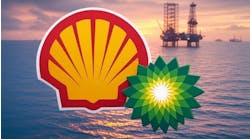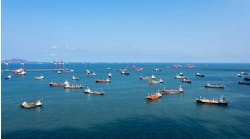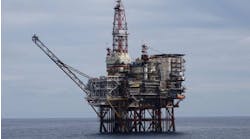Qatar leads the field in gas development
Judy Maksoud
International Editor
The Caspian Sea has become a focus for the US as the country looks for energy resources outside the Middle East. On behalf of the federal government, the US State Department is promoting investment in the oil and gas industry in the Caspian Sea and is taking pains to smooth the way for American companies to invest in the northern Caspian.
Though the Caspian Sea unarguably has great potential, it would be a mistake to think the region can provide an immediate solution to the US energy security problem. Much of the sea is underexplored, and the lead time for development is long. Despite that, interest is high, and opportunities are multiplying.
This year, Kazakhstan and Azerbaijan will continue to attract the most interest, for several reasons. One is that the reserves estimates are highest for the segments of the Caspian they control. The other is that they have already seen significant successes.
null
In the southern part of the sea, the Iranian sector is likely to see more exploration drilling than Turkmenistan, in part because the state oil company is investing in E&P efforts.
Russia
The Energy Information Association places proven reserves in the Russian Caspian at 2.7 Bbbl of oil. New seismic could help to identify reserves locations soon.
In late July 2002, Lukoil was awarded the right to develop Russia's half of the Khvalynskoye field in the northern Caspian Sea. Kazakhstan's state-owned oil and gas company KazMunaiGaz will develop the other half of the field.
This announcement emerged from a meeting of five of the Caspian littoral states that took place in Tehran, Iran, in 3Q 2002. The Khvalynskoye field was one of three fields divided between Russia and Kazakhstan.
Lukoil and KazMunaiGaz signed a memorandum of understanding in February to pursue joint geological study and exploration of the north Caspian.
The short-term objective is to gather new seismic data to delineate the area. The longer-term objective appears to be the creation of a joint venture by the end of the year.
Kazakhstan
The agreement between Kazakhstan and Russia to divide the northern part of the Caspian could expedite E&P in the area.
In March, China National Offshore Oil Co. bought half of the BG Group's interest in the 5,600-sq-km North Caspian Sea production sharing agreement. Weeks later, BG agreed to sell its remaining interest to Sinopec.
At about the same time, KazMunaiGas tendered for seismic work on the Zhambai South and South Zaburunye structures in the Kazakh sector of the Caspian. Lukoil committed to financing the $150-$170 million seismic program, which will include two to four exploration wells.
Early this year, ExxonMobil and Kazakhstan agreed to work on a long-term plan to develop natural gas reserves. Kazakhstan plans to raise gas output to 50 bcm/yr in 2005 when it begins developing the Kashagan field, 16.7% of which belongs to ExxonMobil.
Last June, Agip KCO announced the commercial launch of the Kashagan field, with recoverable reserves of 7-9 Bbbl of oil. Agip is planning to drill several wells on the Kashagan and Kalamkas A blocks in the coming year. Development is expected in 2005. Shell has also announced its readiness to participate in the development of new oil blocks in the Kazakh sector.
Turkmenistan
Though Turkmenistan has world-class res-erves, it has two significant things working against it. The first is that it has been eclipsed by neighboring Kazakhstan and Azerbaijan. The second is a stifling commercial environment that does not encourage foreign investment.
Unfortunately, some of the companies that have braved investment obstacles have not been able to stay involved for the long haul. UAE's Dragon Oil holds a production sharing contract on the Cheleken block. In January, Dragon completed the testing of well LAM 22-105, the fifth and last of a series of development wells to be drilled on the LAM 22 platform. Dragon said it exceeded its 15,000 b/d oil output target for 2002 at the Lam 22 oil platform. Despite its success, the company is not moving forward with the project. Continuation of the drilling program depends on funding, which has not been secured. The drilling program will likely be deferred until later in 2003.
Production has not yet started on block 1, where Malaysia's Petronas Carigali has a contract. To date, two exploration wells have been drilled on block 1. Both tested commercial volumes of oil, natural gas, and condensates.
Mærsk Oil & Gas was awarded two exploration licenses in October of last year. The contract covers E&P work on blocks 11 and 12. No work is being done yet on these blocks.
For the foreseeable future, Turkmenistan will remain the least attractive segment of the Caspian Sea in terms of investment.
Azerbaijan
AIOC produced 1.03 million tons of oil from the BP-operated Chirag field in the first two months of 2003. Planned production from Chirag this year is 6.45 million tons.
The 5.2-Bbbl Azeri-Chirag-Guneshli (ACG) field continues to see development. Pre-drilling at Central Azeri will be completed by mid-year, followed by pre-drilling at West Azeri. When ACG is in full swing, BP will spend $2 million a day drilling and will have up to eight rigs running at any time off Azerbaijan, according to BP's George Siler, vice president for ACG phase three full field development. Phases 2 and 3 will lead to production of over 1 MMbbl/d by 2009.
The Shah Deniz field southeast of Baku is another significant project offshore Azerbaijan. Shah Deniz covers 860 sq km and holds estimated reserves of 1.5-3 Bbbl of oil and 400 bcm of gas. The Turkish government's inability to commit to imports delayed the first phase of the project.
The announcement of approval for construction on Shah Deniz early this year brought praise from the US State Department. Spokesman Richard Boucher called the project, "a milestone in the development of the East-West Energy Corridor."
According to US Ambassador to Azerbaijan Ross Wilson, the US will supply $7-8 million in technical assistance and equipment to Azerbaijan in the coming year.
The Baku-Tbilisi-Ceyhan (BTC) pipeline, on which construction began early this year, is one of the region's major accomplishments. The pipeline is expected to transport Caspian oil over to Ceyhan, Turkey, in early 2005.
Wilson cited the BTC pipeline as a particularly noteworthy achievement for the country. "This project is going to be a big-big-big contribution to Azerbaijan's success as an independent market economy and to its success as an important energy producing country. And I think it will be a catalyst for development generally of Caspian energy resources," he said.
Middle East
United Arab Emirates
The UAE is made up of seven emirates: Abu Dhabi, Ajman, Dubai, Fujairah, Ras al-Khaimah, Sharjah, and Umm al-Qaiwain. The UAE holds 97.8 Bbbl of oil, 95% of which is in Abu Dhabi.
Last May, Abu Dhabi National Oil Co., Abu Dhabi Marine Operations Co., and the Zakum Development Co. completed phase one of a project to identify hydrocarbons and expand the output capacity of the 10-Bbbl Zakum field. The companies carried out an enormous geophysical, 3D seismic survey that covered 1,500 sq km and took nearly a year and a half to complete.
The other significant development is the $3.5-billion Dolphin project, which will move gas and condensate from Qatar's offshore North Field and export the gas to the UAE.
Development drilling and engineering studies are underway. Construction on the upstream production and processing facilities and the pipeline is expected to begin this year.
Though the government of Qatar has expressed interest in developing the country's oil resources, most of the recent efforts have targeted gas.
In June 2002, ExxonMobil Corp. announced that a heads of agreement (HOA) had been signed for Qatar to supply LNG to the UK. The HOA covers the development of two LNG trains, which are expected to be the largest ever built by industry. The feed gas for these trains is to come from Qatar's giant North field, which has proven natural gas reserves exceeding 900 tcf. LNG shipment is scheduled to begin in 2006-2007 and will extend over 25 years.
In late March 2003, Qatar Petroleum and ExxonMobil Middle East Gas Marketing Ltd. launched phase one of Al Khaleej Gas. Al Khaleej Gas will produce gas from Qatar's North field, recover associated condensate and natural gas liquids for sale, and will market 1.75 bcm/d of pipeline gas for domestic and export customers. First gas is scheduled for 4Q 2005.
Bahrain
In July 2002, Petronas Carigali was officially given the right to explore offshore Bahrain. The award covers the 705-sq-km block IV and the 842-sq-km block VI off the northern coast. Development and production plans stretch over the next 24 years.
In late September 2002 ChevronTexaco began drilling its first exploration well on block V, and the following month, EnCana was awarded a 50% stake in the block.
Saudi Arabia
The vast majority of the Saudi Arabia's reserves are onshore, but the country is also home to the 19-Bbbl Safaniya field, the world's largest offshore oilfield. Other offshore oil production includes the Zuluf field, with >500,000 b/d capacity, and the Marjan field, which produces 270,000 b/d.
Two producing fields are in the neutral zone Saudi Arabia shares with Kuwait. The Khafji and Hout fields produce about 300,000 b/d. Saudi Arabia also jointly produces oil with Bahrain at a rate of 140,000 b/d from the Abu Safa field. Last July, Saudi Aramco announced the objective of doubling production from Abu Safa by next year. Field development work in 2003 will be directed toward achieving that goal.
As the US reduces oil imports from Saudi Arabia, the country has looked to Asian markets. Export numbers are expected to change significantly over the next few years.
Kuwait
Kuwait Gulf Oil Co. is looking to invite bids this summer for the upstream development of the Dorrah gas field in the partitioned zone between Saudi Arabia and Kuwait. The company plans to invest $1 billion over the next five years to increase oil production from offshore fields in the Kuwait-Saudi Neutral Zone. The goal is to reach 500,000 b/d production.
In July of last year, Japan's Arabian Oil Co. was looking to participate in developing the field. KGOC and AOC had reached a broad agreement on a deal that would replace AOC's 40-year concession in the Kuwaiti side of the Neutral Zone. But when the concession expired in January 2003, KGOC took over the Kuwaiti interest in the zone.
KGOC plans to invite companies to gather seismic surveys in the field to evaluate the potential for development.
Oman
Oman saw a new offshore discovery late last year that has turned into a substantial opportunity. In December, Lucky Goldstar International Corp. announced the discovery of the Tibat field off the Musandam Peninsula, near the Novus Petroleum-operated Bukha gas-condensate field.
Tibat-1 well results, publicized in March 2003, indicate the field tested 10-12 MMcf/d of gas. The Tibat prospect targeted the same two reservoirs that are the producing zones in the Bukha field. Field appraisal is ongoing.
Early this year, the government of the Sultanate of Oman announced that blocks 18A, 18B, and 41 in the Gulf of Oman will be licensed this year. The blocks cover a 45,240-sq-km area.
The licensing round opened Jan. 15, 2003, and is scheduled to close July 15, 2003.
Yemen
Yemen has opened 33 oil exploration blocks across the country, including several offshore blocks, to foreign investment.
Kuwait Petroleum Exploration Co. (Kufpec) has targeted Yemen as one of its core regions for growth over the next five years. A Kufpec-led consortium was awarded a contract in mid 2001 to develop Yemen's first offshore field. Progress toward that goal has been confined to technical and geophysical studies.
It will be some time before there is significant activity in Yemen's offshore.
Iran
US sanctions prevent American companies from investing in Iran, but that has not stopped foreign investors from taking advantage of investment opportunities.
Late last year, Statoil took heat from the US as a result of its first development contract in the Middle East. The company agreed to take operatorship and to purchase up to 40% interest in phases six, seven, and eight of Iran's South Pars gas development project in the Persian Gulf. Estimates place South Pars reserves at 280 tcf of gas and over 17 Bbbl of liquids
Norway is looking to increase relations with Iran and will invest $300 million in this project over the next four years. Production is scheduled to begin late in 2004.
India has also moved into the Persian Gulf. In late October 2002, the National Iranian Oil Co. awarded an exploration contract for the offshore Farsi field to three state-owned Indian oil companies.
With players on the world stage changing roles as a result of the war in Iraq, Iran could well find itself in an even more favorable position to attract foreign investors in the coming months.
Iraq
The outcome of the war will determine what happens with hydrocarbon development in Iraq. With the world's second largest proven oil reserves, Iraq has production capacity of 3.1 MMbbl/d. Though production has been curtailed as a result of the hostilities, it will no doubt climb again once full production can safely be resumed.
The speed at which production ramps back up will depend on several factors. Foremost among them will be the extent of damage to the fields.






